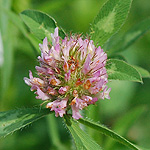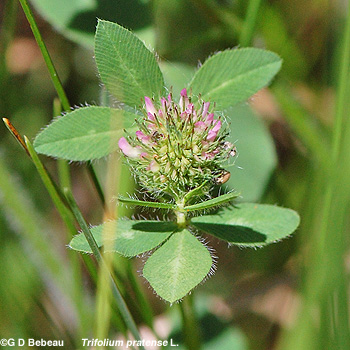The Friends of the Wildflower Garden, Inc.
Plants of the Eloise Butler Wildflower Garden
The oldest public wildflower garden in the United States

Common Name
Red Clover
Scientific Name
Trifolium pratense L.
Plant Family
Pea (Fabaceae)
Garden Location
Upland
Prime Season
Late Spring to Late Summer Flowering
Red Clover is a common introduced and naturalized plant of fields and roadsides.
Stem: Plant height is usually around one foot but some varieties can reach to 30 inches. Unlike the White Clover, Red Clover is usually an erect plant with a hairy stem, sometimes branching.
Leaves: Red Clover has alternate leaves divided into 3-part leaflets that, on the long-stalked larger lower leaves, have a blunt oval shape; a more lance-like shape on the upper leaves, which are stalkless or with short stalks; all leaves with hairy edges and without teeth. On each leaflet you will see a chevron like design that is a paler shade of green, sometimes even white. The smallest leaves are usually directly under the round flower head, where you will also find several green bracts with prominent darker veining. Leaves have very conspicuous stipules sometimes with dark green and sometimes with contrasting purple veining.
The inflorescence is a solitary flower that can arise from the leaf axils and on the stem tip.
Flowers: The flower head is stalkless above the bracts and is a cluster of 27 to 30 stemless tube shaped, 5-petaled magenta flowers that open outward in all directions. The corolla is much longer than the calyx with the 5 petals arranged in pea-like fashion with the largest petal being the standard, or banner, above the others in an erect position with the tip of the lobe notched, 2 lateral petals projecting forward and enclosing the 2 keel petals, hidden within which are the reproductive parts. The upper petal, the standard, is the longest and widest and shows best the delicate veining in a deeper color. Occasionally you may find a white flower. The short green calyx of each flower has 5 long pointed teeth.
Habitat: Red Clover grows from a taproot as a biennial or a short-lived perennial. It was introduced to the United States for livestock food and it's primary use is for hay and silage. As a cover crop it is used for soil improvement as it is a member of the pea family of nitrogen fixing legumes. It is self-sterile and requires pollination by insects, mainly bumblebees as the nectaries are at the bottom of the flower tube. However, it is a source of nectar and pollen for many other bees and butterflies. It usually blooms later than White Clover.
Names: The genus, Trifolium, means three leaves and refers to the 3-parted leaf. The species, pratense, means 'of the meadows' - the plants typical habitat. The author name for the plant classification, 'L.' is for Carl Linnaeus (1707-1778), Swedish botanist and the developer of the binomial nomenclature of modern taxonomy.
Comparisons: For comparison purposes, the White Clover, T. repens, is smaller and less erect, whereas the Yellow and White Sweet Clover, Melilotus officinalis, are tall and branching.


Above: Flowers are solitary atop the stems which can have branching as seen here. Illustration courtesy of Kurt Stüber's Online Library.
Below: 1st photo - Red Clover is an erect plant with the lower leaves on stalks. 2nd photo - The upper petal of the flower has the most delicate dark veining of the five petals.
Below: 1st photo - Flower heads contains 27 to 30 tube flowers of 5 parts. 2nd photo - The more bluntly rounded lower leaf of Red Clover. Note the hair and the lighter color of the chevron in the leaflets.


Below: 1st photo - There are small veined bracts at the base of the flower head. Note also the long-fingered teeth on the calyx of each flower. 2nd photo - A similar veined stipule is at the base of the leaf stalk.


Below: 1st photo - The development of the inflorescence at the growing tip prevents further leaf production so at this stage it is best harvested for hay. 2nd photo - The leaf stipules are very conspicuous and can have green veining as shown above or have this purple veining shown here.
Notes: Eloise Butler had catalogued this plant in her plant index as present in the Garden area on May 25, 1907. It is not a native plant but has become naturalized in most of the counties of the State and appears almost anywhere in North America. It is invasive and spreading must be controlled outside of agriculture, for which purpose, a large number of cultivars of the plant have been developed over the years.
Edible, medicinal lore: The entire plant is edible. Dried flowers are said to make a nice tea. The plant was used by Chinese and western herbalists to thin the blood. Active constituents of the plant are coumarin compounds which are known to thin the blood. (Ref.#39).
Return to -- Site Plan/Archive Index --or-- List of Common Plant Names -- or -- List of Scientific Names -- or --Home Page - - - Back to top.
References: Plant characteristics are generally from sources 1A, 32, W2, W3, W7 & W8 plus others as specifically applied. Distribution principally from W1, W2 and 28C. Planting history generally from 1, 4 & 4a. Other sources by specific reference. See Reference List for details.
 Identification booklet for most of the flowering forbs and small flowering shrubs of the Eloise Butler Wildflower Garden. Details Here.
Identification booklet for most of the flowering forbs and small flowering shrubs of the Eloise Butler Wildflower Garden. Details Here.
©2013
Friends of the Wildflower Garden, Inc. Text and photos are by G. D. Bebeau unless otherwise credited. "www.friendsofeloisebutler.org"
052920